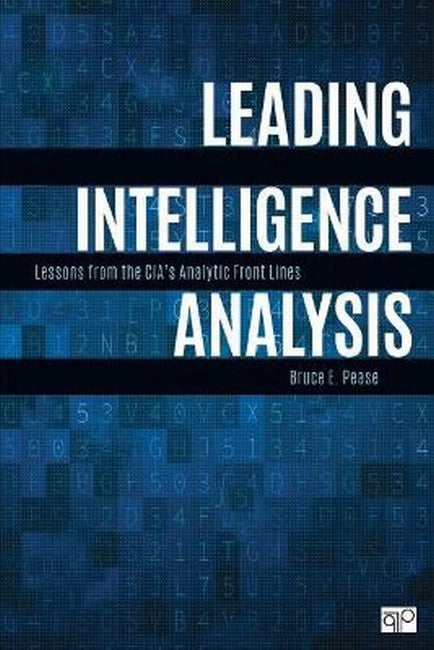Bruce E. Pease is a consultant on national security issues and the application of artificial intelligence; and he teaches leadership, ethics, and analysis. For 17 years, he led CIA's front-burner components, specializing in threats to US security and developing expertise in today's most pressing security issues. In the late 1990s, he led CIA's Office of Near Eastern, South Asian, and African Analysis, providing key policy support during multiple crises in the Middle East. After the 9/11 attacks, he established and led CIA's new Office of Terrorism Analysis and then became Deputy Director of the Counter Terrorism Center. In 2004 he became Director of CIA's Weapons Intelligence, Nonproliferation, and Arms Control Center, analyzing the threat posed by weapons of mass destruction and emerging military technologies. His service also includes work as part of the White House staff, when he was Director of Intelligence Programs on the National Security Council, as well as eight years of active duty in the US Navy.
Request Academic Copy
Please copy the ISBN for submitting review copy form
Description
Foreword Acknowledgments About the Author Chapter 1: Leading Analysis is Different from Doing Analysis The Leader of Analysis or the Uberanalyst Which Substantive Analyst Responsibilities Carry Over? No Lazy Thinking Setting Standards for the First Time Analyze Everything Chapter 2: Understanding Analysts Some Classic Traps Ten Things Analysts Hate Chapter 3: Shaping the Environment Nurturing Trust is Job 1 Taking the Pulse Seven Critical Balances Stress in the Environment Chapter 4: Choosing the Best Approach and Techniques Evolving Approaches: Three Paradigms Picking your paradigm Blending Approaches The Expanding Menu of Analytic Techniques Keep Your Eye Out for New Choices Chapter 5: Nurturing the New Idea: Creativity, Insight, and Innovation in Analysis Creative Analysis? Stifling Creativity and Innovation in Analysis And What of Insight? Promoting Creativity, Innovation, and Insight Chapter 6: Asking the Right Question Toxic Questioning The Right Question The Wrong Question Chapter 7: The Hardest Question: What Is Going to Happen? Prediction and Warning in Analysis Analyzing Predictability When History Pivots Humility, an Open Mind, and Practice Required Prediction is Always a Gamble Prediction is the Leader's Responsibility What's the Worst that Could Happen? Leading Warning What Is Reasonable in an Unreasonable World? Chapter 8: Ethics in Analysis What am I doing in this business? Leading a Dialogue on Values Climbing Down off the Analyst's High Horse Driving Collection Resisting Politicization Are We Responsible for Consequences? Impact of Covert Action In Closing Chapter 9: Analysis as a Business The Business Part of the Business Ensuring Brand Loyalty (Getting Your Customers Hooked on Your Service) Prioritize Your Customers Tend Your Organization's Reputation with the Front Office Align Your Enterprise Business Is Too Good-I'm Swamped! Change is Reality It Doesn't Take an MBA Chapter 10: The Tools of Twenty-First-Century Analysis Judging Tools For Analysis First- and Second-Level IT Tools to Help All Analysts Third-level Tools: Big Data, Data Science, and Predictive Analytics Two Keys: Volume and Repetition The Dreaded-but Inevitable-Black Box The Analyst Is Not About to be Replaced Chapter 11: Analysis at the Speed of Information Get Your Mind Right and Theirs Build an Information Strategy Can we analyze faster? Nurture Your Inner Opportunist Afterword Bibliography Index
"Bruce Pease has written a much needed book on a long ignored topic: how does one lead analysts? Most analysis is, at some level a group activity, whether in government or the private sector. Much has been written about good vs. bad analysis and how to train analysts, but Pease, himself a veteran senior CIA analyst and manger, focuses on what the managers and leaders of these analysts need to know and should be thinking about. Leadership matters in analysis as in all other endeavors and Pease offers invaluable guidance on how best to do this. This book is a must for anyone in a leadership role in an analytic enterprise." -- Mark M. Lowenthal, PhD. "While Director of CIA, I sometimes described the analytic workforce there as resembling a tenured college faculty as I worked to preserve the excellence and independence of thought so essential to success (in either body) while harnessing those energies to a common, disciplined enterprise. Bruce Pease was my guide and counselor for that effort and now Bruce has captured his advice and wisdom in Leading Intelligence Analysis, a must read for any senior in or out of government who leads-or depends on-analysis." -- Michael V. Hayden "A very thoughtful book by a very thoughtful and respected professional. But this book goes way beyond thoughtful. It is exciting - the topics are hard to resist. And it is practical, putting powerful ideas into context. The lessons carry beyond intelligence analysis - they hit home for corporate leaders struggling to make forecasts despite ambiguity, complexity and deception." -- Gary Klein, Ph.D. "Bruce Pease is one of the finest leaders and analysts to ever serve at the Central Intelligence Agency. Few had his ability to cut through complicated issues and provide senior leaders with wisdom. No matter what business you are in, Bruce brings clarity and balance to help get the most out of your forecasters, inundated with data in this digital age. The results will be game changing." -- George Tenet

